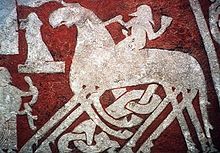Sleipnir
This is the sighted version that was marked on March 15, 2021. There is 1 pending change that needs to be sighted.
![]()
This article describes the horse of Odin in Norse mythology. For other meanings of Sleipnir or Sleipner, see the term Sleipnir (disambiguation).
![]()
This article or subsequent section is not sufficiently supported by evidence (e.g., anecdotal evidence). Information without sufficient evidence may be removed in the near future. Please help Wikipedia by researching the information and adding good supporting evidence.
The article refers to partly outdated sources and scientifically highly controversial statements from Eliade's environment as facts. Almost none of the statements can be substantiated in the specialist literature. References to and quotations from original sources are missing.
Sleipnir (German Schleifner; approximately "the one who glides along", spelling alternatively also Sleipner) refers to the eight-legged horse of the god Odin in the Snorra-Edda and the Song-Edda as well as in some of the Icelandic pre-time sagas of Norse mythology. It got its name because it "glides along" equally on land and water as well as in the air. In the Eddic sources Sleipnir is depicted as the child of the god Loki with the stallion Svaðilfari. According to the saga, Loki had to prevent the timely completion of Asgard because an unnamed Hrimthurse, the builder of the wall around Asgard, desired the goddess Freya as his wife for the completion of the construction work. Loki, in the guise of a mare, kidnapped the giant's stallion, Svaðilfari, who was helping his owner with the work, and begat Sleipnir with him. Thus the stallion was gone for a few days, and the deadline by which Asgard was to be built passed. Loki later gave his child, Sleipnir, to Odin.

Depiction of a person riding a multi-legged horse. It is interpreted by the majority of scholars as a representation of Odin on Sleipnir. (Rune and image stone from Tjängvide G 110), State History Museum, Stockholm

Illustration of Odin on Sleipnir from the Icelandic Edda manuscript NKS 1867 4to by Ólafur Brynjúlfsson from 1760
Theories
John Lindow theorizes that Sleipnir's connection to the world of the dead is a kenning in which Sleipnir appears as a concept according to the skald Úlfr Uggason, who speaks of the "sea Sleipnir" in his Húsdrápa describing Balder's funeral. Lindow argues that Sleipnir's eight legs can be seen as an indicator of great speed.
Reception
Sleipnir is, according to legend, also the reason why the Ásbyrgi Gorge in Iceland is shaped like a horseshoe. When Odin rode him across the deserts of the Arctic, the horse is said to have slipped and set foot on northern Iceland. This is why the gorge is sometimes referred to as Odin's footprint.
Modern esoteric reception
Hilda Ellis Davidson writes that Odin's eight-legged horse is the typical steed of a shaman and that on a shaman's journeys to heaven or the underworld, he is always depicted riding a bird or animal. Davidson further states that while the creature may vary, the horse is usually common in regions where horses are found, and furthermore, Sleipnir's ability to carry the god is a typical characteristic of the shaman's horse.
Davidson refers to the controversial religious phenomenologist Mircea Eliade, who writes that the eight-legged horse is the shaman's horse par excellence. It is found, for example, in Siberia and among the Muria, where it is always related to ecstatic experience. On Sleipnir Odin can ride through all worlds. It is believed by some historians that the eight legs are a symbol for the legs of four people carrying a coffin. Thus, the steed also allows a rider to be carried to the underworld. Odin rides Sleipnir to Niflheim to find out about Balder's dreams.
Search within the encyclopedia